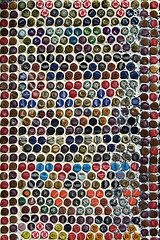

The synthesis of mRNA in cells infected with members of three different viral families, bunyaviruses (to which hantaviruses belong), orthomyxoviruses, and arenaviruses is unusual because it is primed with a 5’capped oligonucleotide derived from cellular mRNAs. These capped primers are cleaved from cell mRNAs by viral endonucleases. After finding that the hantavirus N protein binds short, capped RNAs, the authors wondered whether such oligonucleotides might be stored in P bodies. These are regions of the cytoplasm that contain a variety of enzymes involved in turnover of mRNA; among other activities, they are storage areas for mRNAs that are not being translated into protein. The authors found that the hantavirus N protein localizes to P bodies, where it was associated with 5′-caps. The N protein-associated 5’caps, which were protected from degradation, were also used for viral mRNA synthesis.
Apparently these authors have also found that N protein can replace eIF4F during translation (although the data are not shown). They suggest that N protein remains bound to the 5′-cap structure during initiation of mRNA synthesis, and remains in place after the mRNA is complete. The protein is then in an excellent position to mediate ribosome binding to the mRNA. This model would imply that hantavirus mRNA translation is largely independent of the cap binding protein, eIF4E, a conclusion consistent with previous experimental results. A recent report indicates that influenza mRNA translation does not require eIF4E. Because influenza mRNA synthesis is also primed with capped oligonucleotides, the obvious – yet unproven – conclusion is that these caps are also stored in P bodies.
Thanks to Aidan for the title of this post.
Mir, M., Duran, W., Hjelle, B., Ye, C., & Panganiban, A. (2008). Storage of cellular 5′ mRNA caps in P bodies for viral cap-snatching Proceedings of the National Academy of Sciences, 105 (49), 19294-19299 DOI: 10.1073/pnas.0807211105

but aren't P bodies cytoplasmic? that would seem to contradict a role in storing primers for influenza mRNA synthesis since that presumably occurs in the nucleus?
Correct, influenza mRNA synthesis occurs in the nucleus, while
hantavirus mRNA synthesis is cytoplasmic. In addition, the sensitivity
of influenza mRNA synthesis, but not that of hantaviruses, to the
inhibitor amantadine has been interpreted to mean that influenza mRNA
synthesis cannot utilize the pool of cytoplasmic mRNAs as primers;
rather it must derived capped primers from newly synthesized cellular
nuclear mRNA pools. Therefore it is not likely that there is a role
for P bodies in influenza mRNA synthesis . But perhaps there is a yet
undiscovered nuclear equivalent?
I was poking around the web because I had heard a seminar by Panganiban recently and I gave a lecture today on RNA synthesis from RNA templates. So your comment above, “Because influenza mRNA synthesis is also primed with capped oligonucleotides, the obvious – yet unproven – conclusion is that these caps are also stored in P bodies.” made me think there might be some other new info I was missing. Hence the questions!
Great site.
(LAS—-your colleague in MN)
Dear professor,
When I read some papers I found that the huntavirus N protein was reported to related to mRNA synthesis, but the influenza virus seems not, it that right? So if we wanna check this mechanism what should we do fist, since no protein seems to function like huntavirus N protein as far as I know.
Influenza NP maintains the viral RNA in a transcriptionally active form and in this sense is important for mRNA synthesis. In addition, a nuclear localization signal on NP is needed for import of the viral RNA into the nucleus of the cell, where viral mRNA synthesis takes place. Given these observations, plus the fact that influenza mRNA synthesis occurs in the nucleus, it seems unlikely that NP would localize to P bodies, which are cytoplasmic. But it's easy enough to try – stain cells with antibodies to NP and a P body marker.
Influenza NP maintains the viral RNA in a transcriptionally active form and in this sense is important for mRNA synthesis. In addition, a nuclear localization signal on NP is needed for import of the viral RNA into the nucleus of the cell, where viral mRNA synthesis takes place. Given these observations, plus the fact that influenza mRNA synthesis occurs in the nucleus, it seems unlikely that NP would localize to P bodies, which are cytoplasmic. But it's easy enough to try – stain cells with antibodies to NP and a P body marker.
Looks like you’ve done your research very well.